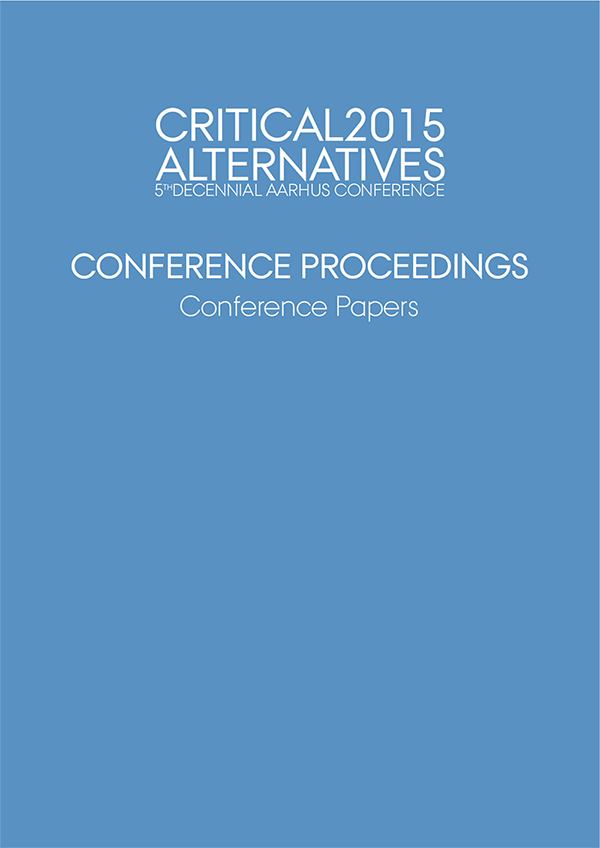On Creating and Sustaining Alternatives: The case of Danish Telehealth
DOI:
https://doi.org/10.7146/aahcc.v1i1.21297Keywords:
Contexts for design, sustaining results, control, Participatory Design, software eco-systems, innovation, Open Source, telehealth, telemedicine, healthcare technologyAbstract
This paper presents and discusses an initiative aimed at creating direct and long lasting influence on the use and development of telemedicine and telehealth by healthcare professionals, patients and citizens. The initiative draws on ideas, insights, and lessons learned from Participatory Design (PD) as well as from innovation theory and software ecosystems. Last, but not least, the ongoing debate on public finances/economy versus tax evasion by major private companies has been an important element in shaping the vision and creating support for the initiative. This vision is about democratic control, about structures for sustaining such control beyond initial design and imple- mentation and about continued development through Participatory Design projects. We see the “middle element”, the structures for sustaining democratic control beyond initial design and implementation as the most important and novel contribution of the paper.
References
4S webpage. Available from: http://4S-online.dk.
Ehn, P. and M. Kyng, The Collective Resource Approach to Systems Design, in Computers and Democracy. 1987, Avebury: Aldershot, UK. p. 17-57.
Bødker, S., et al., Co-operative Design—perspectives on 20 years with ‘the Scandinavian IT Design Model’, in Proceedings of NordiCHI 2000. 2000: Stockholm, Sweden. p. 22-24.
Kyng, M., Users and computers: A contextual approach to design of computer artifacts. Scandinavian Journal of Information Systems, 1998. 10(1&2): p. 7-44.
Kyng, M., Bridging the Gap Between Politics and Techniques: On the next practices of participatory design. Scandinavian Journal of Information Systems, 2010. 22(1): p. 49-68.
Christensen, H.B., et al., Analysis and design of software ecosystem architectures – Towards the 4S telemedicine ecosystem. Special issue on Software Ecosystems, 2014. 56(11): p. 1476-1492.
PalCom project webpage. Available from: http://www.ist-palcom.org/.
Statens Serum, I. and I.T. National Sundheds, Referencearkitektur for opsamling af helbredsdata hos borgeren. 2013, National Sundheds-IT: København.
The UNIK partnership conference. 2013; Available from:http://www.partnerskabetunik.dk/media/38318/opdateret invitation.pdf
Steventon, A., et al., Effect of telehealth on use of secondary care and mortality: findings from the Whole System Demonstrator cluster randomised trial. BMJ (Clinical research ed.), 2012. 344: p. e3874
EU project Renewing Health. Available from: http://www.renewinghealth.eu/en/.
the Telecare Nord project on COPD. Available from: http://www.rn.dk/Sundhed/Til-sundhedsfaglige-og- samarbejdspartnere/TeleCare-Nord.
Tidd, J. and J. Bessant, Managing innovation : integrating technological, market and organizational change. Vol. 4th. 2009, New York: Wiley. 638.
Abernathy, W. and J. Utterback, Patterns of industrial innovation. MIT Technology Review, 1978(6): p. 40- 47.
The BYTE awards : GRID System's GRiDPad. BYTE Magazine, 1990. 15(1): p. 285-286.
Christensen, C.M., The Innovator's Dilemma : When New Technologies Cause Great Firms to Fail. 1997, Harward: Harvars Business Press. 225.
Epic Systems Corporation. Available from: http://en.wikipedia.org/wiki/Epic_Systems.
Manikas, K. and K.M. Hansen, Software ecosystems – A systematic literature review. Journal of Systems and Software, 2013. 86(5): p. 1294-1306.
Fælles vej frem for telemedicin til glæde for både patienter og erhvervsliv. 02.02.2015; Available from:http://www.regioner.dk/aktuelt/nyheder/2015/februar/f %C3%A6lles+vej+frem+for+telemedicin+til+gl%C3 %A6de+for+b%C3%A5de+patienter+og+erhvervsliv.
Porter, M. June 6, 2006, Mandag Morgen: Copenhagen, Denmark.
Goodwin, N., Jumping the gun in the telehealth steeplechase. 2012.
Piketty, T., Capital in the Twenty-First Century. 2014: Harvard University Press.
Mazzucato, M., The entrepreneurial state : debunking public vs. private sector myths. Anthem frontiers of global political economy. 2013, London: Anthem Press. 237.
Scandinavian J of Information Systems, 1998. 10.
Scandinavian J of Information Systems, 2003. 15.
Scandinavian J of Information Systems, 2010. 22.
Shapiro, D., Participatory design: the will to succeed, in Proceedings of the 4th decennial conference on Critical computing: between sense and sensibility. 2005, ACM: Aarhus, Denmark. p. 29-38.
Schwaber, K. Controlled Chaos : Living on the Edge 1996.
Nygaard, K., The ‘Iron and metal project’: trade union participation, in Computers Dividing Man and Work – Recent Scandinavian Research on Planning and Computers from a Trade Union Perspective., Å. Sandberg, Editor. 1979, Swedish Center for Working Life, Demos Project report no. 13, Utbildningsproduktion: Malmö, Sweden. p. 94-107.
Bødker, S., et al., A Utopian Experience. Proceedings of the 1986 Conference on Computers and Democracy, 1987: p. 251-278.
Ehn, P. and M. Kyng, Cardboard Computers: Mocking-it-up or Hands-on the Future, in Design at work: Cooperative design of computer systems, J. Greenbaum and M. Kyng, Editors. 1991, Lawrence Erlbaum Associates, Inc.: Hillsdale, New Jersey, USA. p. 169-195.
Proceedings of PDC 2012, The Participatory Design Conference. 2012: Roskilde, Denmark.
Grönvall, E. and M. Kyng, Beyond Utopia: reflections on participatory design in home-based healthcare with weak users, in Proceedings of the 29th Annual European Conference on Cognitive Ergonomics. 2011, ACM: Rostock, Germany. p. 189-196.
Christensen, L.R. and E. Grönvall, Challenges and Opportunities for Collaborative Technologies for Home Care Work, in ECSCW 2011: Proceedings of the 12th European Conference on Computer Supported Cooperative Work, 24-28 September 2011, Aarhus Denmark, S. Bødker, et al., Editors. 2011, Springer London. p. 61-80.
Fitzpatrick, G. and G. Ellingsen, A Review of 25 Years of CSCW Research in Healthcare: Contributions, Challenges and Future Agendas. Computer Supported Cooperative Work (CSCW), 2012: p. 1-57.
Bertelsen, W.O., et al., Therapeutic Strategies - a Challenge for User Involvement in Design, in Workshop at NordiChi 2010, The 6th Nordic Conference on Human-Computer Interaction. 2010: Reykjavik, Iceland.
Gulliksen, J., et al., Key principles for user-centred systems design. Behaviour & Information Technology, 2003. 22(6): p. 397-409.
Beck, E.E., P for Political: Participation is Not Enough. Scandinavian Journal of Information Systems, 2002. 14(1): p. 77-92.
Iversen, O.S. and C. Dindler, Sustaining participatory design initiatives. CoDesign: International Journal of CoCreation in Design and the Arts, 2014. 10(3-4): p. 153-170.
iHospital. Det Interaktive Hospital. 2005; Available from: http://www.ihospital.dk/.
Cetrea. Clinical Logostics. 2015; Available from: http://www.cetrea.com/index.php/en/.




